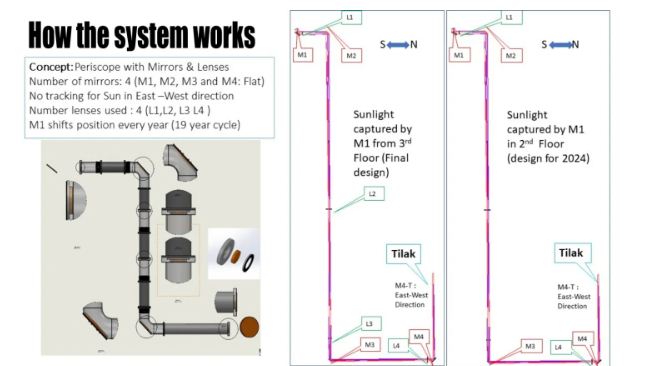April 18, 2024
Surya Tilak Project :
Why in News ? The Surya Tilak Project aims to bring Sun rays on the forehead of Lord Ram at Ayodha Temple during the Ram Navami.
This is the first Ram Navami since the consecration of the Ram idol at the new temple on January 22.
· This was achieved using a special mirror-lens arrangement, designed by astronomers at the Indian Institute of Astrophysics (IIA), Bengaluru, that has been installed in the building by a team from the Central Building Research Institute, Roorkee.
The science behind Ram Lalla’s Surya Tilak:/ How will it work?
Step 1: Predict the Sun’s position (each year):
As per the Gregorian calendar, the date of Ram Navami (the Hindu festival celebrating the birth of Lord Ram) varies each year. This is because the Gregorian calendar is a solar calendar (based on Earth’s revolution around the Sun — while the Hindu calendar is a lunar calendar (based on the Moon’s revolution around Earth — one revolution equals to one month).
A solar year has roughly 365 days, whereas a lunar year is roughly 354 days long.
Step 2: To channelise the Sun’s rays:
· After astronomers estimated where the Sun will be in the sky, their second task was to channelise the sunbeam in a manner that it will fall on the idol’s forehead for a certain amount of time.
· The IIA team proposed a four-mirror-and-four-lens array for this purpose. “The first mirror, responsible for receiving the sunlight, has to be positioned at an angle along the path of the sun rays.
· The light will then be reflected to three other mirrors, and will pass through four lenses until it is of the desired intensity, and will be directed to the idol’s forehead. The mirrors directed the beams while the lenses made them converge to the required intensity.
This opto-mechanical system operates on a principle similar to that of a periscope — like the ones you used to make for school projects . Given that the sun’s position vis-à-vis the first mirror will vary each year, a specially designed 19-gear system was built to make requisite adjustments.
About 19-gear system:
· Once a year, one tooth of the gear will have to be manually turned so that the angle of the pickup mirror (first mirror) is adjusted, and it is ready to capture the Sun’s rays.
· The number 19 was chosen to correspond to the Metonic cycle — a period of 19 years in which there are 235 lunar months, after which the Moon’s phases recur on the same days of the solar year. This means that every 19 years, the system will effectively reset, and the cycle will then begin again.
What is optomechanics?
· Optical devices are all around us, from the zoom lens of a camera to optical instruments in a spacecraft. The knowledge used to develop these systems comes from optomechanics, a combination of optical and mechanical engineering.
Opto-mechanical engineers combine optical and mechanical engineering to develop optical systems and devices such as lasers and lenses

January 30, 2025
January 20, 2025
January 14, 2025
